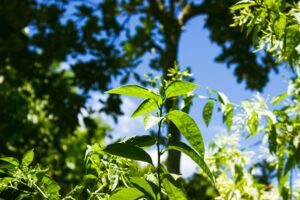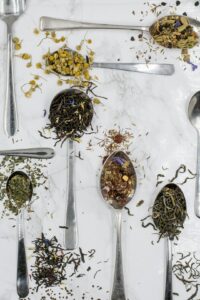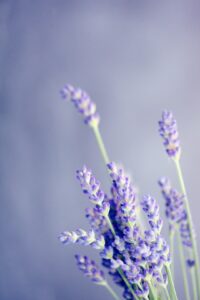Support our educational content for free when you purchase through links on our site. Learn more
12 Must-Have Herbs to Grow for Tea in 2023
Quick Answer:
Looking to create your own homemade herbal tea blends? We’ve got you covered! In this article, we’ll introduce you to 12 must-have herbs to grow for tea in 2023. From chamomile to lavender, these herbs will not only add incredible flavor to your tea but also provide numerous health benefits. So, let’s dive in and discover the wonderful world of herbal tea gardening!
Quick Tips and Facts:
- Growing your own herbs for tea is not only cost-effective but also allows you to have complete control over the quality and freshness of your ingredients.
- Most herbs used for tea prefer well-drained soil and require at least 4-6 hours of sunlight per day.
- Harvest your herbs in the morning when the essential oils are at their peak for the best flavor and aroma.
- Drying herbs for tea is a great way to preserve them for future use. Hang them upside down in a cool, dry place until they are completely dry, then store them in airtight containers.
Background: The Art of Herbal Tea Gardening
Creating your own herbal tea blends is a delightful and rewarding experience. Not only do you get to enjoy the flavors and aromas of freshly brewed tea, but you also have the opportunity to explore the healing properties of various herbs. Herbal tea gardening allows you to connect with nature, nurture your plants, and savor the fruits of your labor. So, let’s embark on this journey together and discover the best herbs to grow for tea in 2023.
1. Chamomile (Matricaria recutita or Anthemis nobilis)
Chamomile is a classic herb known for its calming properties. It has a delicate floral flavor with hints of apple and is often used to promote relaxation and improve sleep quality. Chamomile tea is also known to soothe digestive issues and reduce inflammation. To grow chamomile, plant the seeds in well-drained soil and provide ample sunlight. Harvest the flowers when they are fully open and dry them for future use.
- Benefits: Calming, aids digestion, reduces inflammation.
- Drawbacks: May cause allergic reactions in some individuals.
- Recommended Brands: Check Price on Amazon | Shop Traditional Medicinals on Walmart | Traditional Medicinals Official Website
2. Rosehip (Rosa sp.)
Rosehip tea is a delightful and tangy herbal infusion made from the fruit of the wild rose. It is rich in vitamin C and antioxidants, making it a great immune booster. Rosehip tea also supports healthy skin and may help reduce joint pain. To grow rosehips, plant rose bushes in well-drained soil and provide them with plenty of sunlight. Harvest the ripe rosehips in the fall and dry them for tea.
- Benefits: High in vitamin C, boosts immune system, supports healthy skin.
- Drawbacks: May interact with certain medications.
- Recommended Brands: Check Price on Amazon | Shop Alvita on Walmart | Alvita Official Website
3. Rosemary (Salvia rosmarinus, formerly Rosmarinus officinalis)
Rosemary is a versatile herb that adds a delightful aroma and flavor to tea blends. It has a refreshing and slightly piney taste with hints of citrus. Rosemary tea is known for its cognitive benefits, helping to improve memory and concentration. It also has antioxidant and anti-inflammatory properties. To grow rosemary, plant it in well-drained soil and provide it with full sun. Harvest the leaves as needed and dry them for tea.
- Benefits: Improves memory and concentration, antioxidant, anti-inflammatory.
- Drawbacks: Should be avoided during pregnancy.
- Recommended Brands: Check Price on Amazon | Shop Celebration Herbals on Walmart | Celebration Herbals Official Website
4. Fennel (Foeniculum vulgare)
Fennel is a flavorful herb with a distinct licorice-like taste. It is commonly used to aid digestion and relieve bloating. Fennel tea is also known for its calming effects and may help alleviate menstrual discomfort. To grow fennel, plant the seeds in well-drained soil and provide it with full sun. Harvest the leaves and seeds as needed and dry them for tea.
- Benefits: Aids digestion, relieves bloating, calming.
- Drawbacks: May cause allergic reactions in some individuals.
- Recommended Brands: Check Price on Amazon | Shop Buddha Teas on Walmart | Buddha Teas Official Website
5. Mint (Mentha sp.)
Mint is a refreshing herb that adds a burst of flavor to tea blends. It has a cool and invigorating taste with hints of sweetness. Mint tea is known for its digestive benefits and can help relieve nausea and indigestion. It also has a soothing effect on the respiratory system. To grow mint, plant it in well-drained soil and provide it with partial shade. Harvest the leaves as needed and dry them for tea.
- Benefits: Aids digestion, relieves nausea, soothing for the respiratory system.
- Drawbacks: Can be invasive if not contained.
- Recommended Brands: Check Price on Amazon | Shop Traditional Medicinals on Walmart | Traditional Medicinals Official Website
6. Lemon Balm (Melissa officinalis)
Lemon balm is a lemon-scented herb that adds a bright and citrusy flavor to tea blends. It has a calming effect on the nervous system and can help reduce anxiety and promote relaxation. Lemon balm tea is also known for its antiviral properties and may help alleviate cold sores. To grow lemon balm, plant it in well-drained soil and provide it with partial shade. Harvest the leaves as needed and dry them for tea.
- Benefits: Calming, reduces anxiety, antiviral.
- Drawbacks: May cause drowsiness in some individuals.
- Recommended Brands: Check Price on Amazon | Shop Traditional Medicinals on Walmart | Traditional Medicinals Official Website
7. Lemon Verbena (Aloysia citrodora)
Lemon verbena is a fragrant herb with a strong lemony aroma and flavor. It adds a refreshing and citrusy twist to tea blends. Lemon verbena tea is known for its digestive benefits and can help relieve indigestion and bloating. It also has antioxidant properties and may support healthy skin. To grow lemon verbena, plant it in well-drained soil and provide it with full sun. Harvest the leaves as needed and dry them for tea.
- Benefits: Aids digestion, relieves indigestion, antioxidant.
- Drawbacks: May cause allergic reactions in some individuals.
- Recommended Brands: Check Price on Amazon | Shop Celebration Herbals on Walmart | Celebration Herbals Official Website
8. Lavender (Lavandula sp.)
Lavender is a fragrant herb with a floral and slightly sweet flavor. It adds a touch of elegance to tea blends and is known for its calming effects. Lavender tea can help reduce anxiety and promote restful sleep. It also has antioxidant and anti-inflammatory properties. To grow lavender, plant it in well-drained soil and provide it with full sun. Harvest the flowers when they are fully open and dry them for tea.
- Benefits: Calming, reduces anxiety, antioxidant, anti-inflammatory.
- Drawbacks: May cause allergic reactions in some individuals.
- Recommended Brands: Check Price on Amazon | Shop Traditional Medicinals on Walmart | Traditional Medicinals Official Website
9. Coneflower (Echinacea sp.)
Coneflower, also known as echinacea, is a powerful herb that supports the immune system. It has a slightly bitter taste with hints of sweetness. Echinacea tea is commonly used to prevent and shorten the duration of colds and flu. It also has anti-inflammatory properties and may help alleviate symptoms of seasonal allergies. To grow coneflower, plant it in well-drained soil and provide it with full sun. Harvest the flowers when they are fully open and dry them for tea.
- Benefits: Boosts immune system, anti-inflammatory, may alleviate allergy symptoms.
- Drawbacks: May cause allergic reactions in some individuals.
- Recommended Brands: Check Price on Amazon | Shop Traditional Medicinals on Walmart | Traditional Medicinals Official Website
10. Bee Balm (Monarda didyma)
Bee balm, also known as bergamot, is a vibrant herb with a citrusy and minty flavor. It adds a unique twist to tea blends and is known for its soothing properties. Bee balm tea can help relieve headaches and promote relaxation. It also has antimicrobial properties and may support healthy digestion. To grow bee balm, plant it in well-drained soil and provide it with full sun. Harvest the leaves and flowers as needed and dry them for tea.
- Benefits: Soothing, relieves headaches, antimicrobial.
- Drawbacks: May cause allergic reactions in some individuals.
- Recommended Brands: Check Price on Amazon | Shop Celebration Herbals on Walmart | Celebration Herbals Official Website
11. Lemon Grass (Cymbopogon citratus)
Lemon grass is a fragrant herb with a distinct lemony flavor. It adds a zesty and refreshing twist to tea blends. Lemon grass tea is known for its digestive benefits and can help relieve stomach cramps and bloating. It also has antibacterial properties and may support healthy digestion. To grow lemon grass, plant it in well-drained soil and provide it with full sun. Harvest the leaves as needed and dry them for tea.
- Benefits: Aids digestion, relieves stomach cramps, antibacterial.
- Drawbacks: May cause allergic reactions in some individuals.
- Recommended Brands: Check Price on Amazon | Shop Buddha Teas on Walmart | Buddha Teas Official Website
12. Spearmint (Mentha spicata)
Spearmint is a refreshing herb with a sweet and minty flavor. It is often used in tea blends to add a cool and invigorating taste. Spearmint tea is known for its digestive benefits and can help relieve indigestion and nausea. It also has antimicrobial properties and may support oral health. To grow spearmint, plant it in well-drained soil and provide it with partial shade. Harvest the leaves as needed and dry them for tea.
- Benefits: Aids digestion, relieves indigestion, antimicrobial.
- Drawbacks: Can be invasive if not contained.
- Recommended Brands: Check Price on Amazon | Shop Traditional Medicinals on Walmart | Traditional Medicinals Official Website
FAQ
What herbs can you grow for tea?
You can grow a wide variety of herbs for tea, including chamomile, rosehip, rosemary, fennel, mint, lemon balm, lemon verbena, lavender, coneflower, bee balm, lemon grass, and spearmint.
Read more about “How to Grow Tea Plants Indoors …”
What herbs are good to make tea with?
Some popular herbs to make tea with include chamomile, rosehip, rosemary, fennel, mint, lemon balm, lemon verbena, lavender, coneflower, bee balm, lemon grass, and spearmint.
What herbs are common in tea?
Common herbs used in tea include chamomile, rosehip, rosemary, fennel, mint, lemon balm, lemon verbena, lavender, coneflower, bee balm, lemon grass, and spearmint.
Read more about “What Herbs Can You Grow Indoors for Tea? …”
How do I grow tea in my backyard?
To grow tea in your backyard, choose a suitable variety of tea plant, such as Camellia sinensis. Provide well-drained soil and partial shade. Water regularly and protect the plants from extreme temperatures. Harvest the leaves when they are young and tender, then process and dry them to make your own tea.
Read more about “… Can You Grow Tea in Ohio? A Comprehensive Guide”
Conclusion
Growing your own herbs for tea is a rewarding and enjoyable experience. Not only do you get to savor the flavors and aromas of freshly brewed tea, but you also have the opportunity to explore the healing properties of various herbs. From chamomile to spearmint, these 12 must-have herbs will elevate your tea-drinking experience and provide numerous health benefits. So, grab your gardening tools and start growing your own herbal tea garden today!
Recommended Links
- Green Tea Cultivation
- Herbal Tea Planting
- Tea Plant Varieties
- Soil and Climate for Tea
- How to Grow Tea Plants Indoors 2023
Reference Links
- Farm to Jar: 8 Best Herbs for Tea Garden
- Chamomile Tea on Amazon
- Traditional Medicinals Chamomile Tea on Walmart
- Traditional Medicinals Official Website
- Rosehip Tea on Amazon
- Alvita Rosehip Tea on Walmart
- Alvita Official Website
- Rosemary Tea on Amazon
- Celebration Herbals Rosemary Tea on Walmart
- Celebration Herbals Official Website
- Fennel Tea on Amazon
- Buddha Teas Fennel Tea on Walmart
- Buddha Teas Official Website
- Mint Tea on Amazon
- Traditional Medicinals Mint Tea on Walmart
- Lemon Balm Tea on Amazon
- Traditional Medicinals Lemon Balm Tea on Walmart
- Lemon Verbena Tea on Amazon
- Celebration Herbals Lemon Verbena Tea on Walmart
- Lavender Tea on Amazon
- Traditional Medicinals Lavender Tea on Walmart
- Coneflower Tea on Amazon
- Traditional Medicinals Echinacea Tea on Walmart
- Bee Balm Tea on Amazon
- Celebration Herbals Bee Balm Tea on Walmart
- Lemon Grass Tea on Amazon
- Buddha Teas Lemon Grass Tea on Walmart
- Spearmint Tea on Amazon
- Traditional Medicinals Spearmint Tea on Walmart









